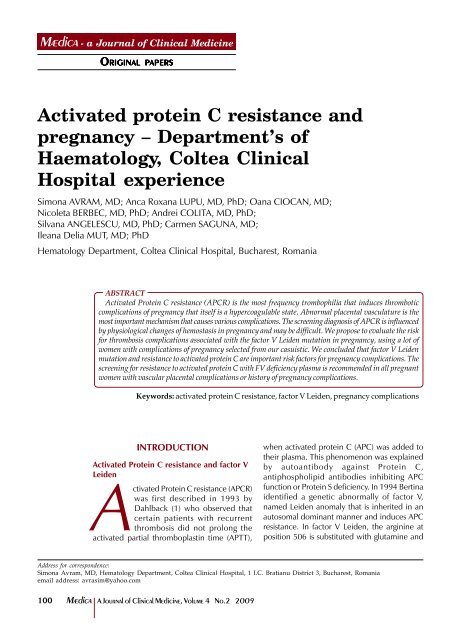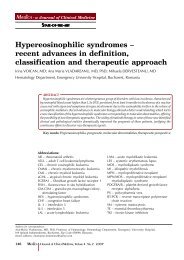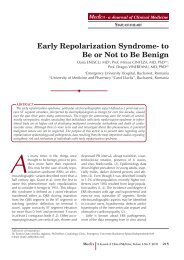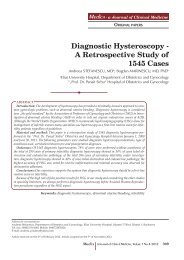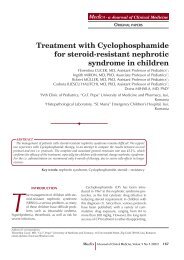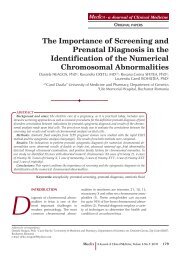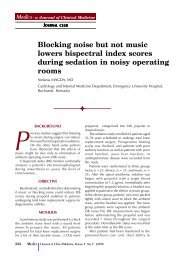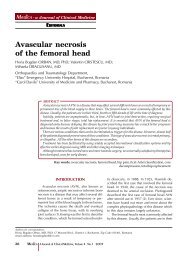Activated protein C resistance and pregnancy - MÃDICA - a Journal ...
Activated protein C resistance and pregnancy - MÃDICA - a Journal ...
Activated protein C resistance and pregnancy - MÃDICA - a Journal ...
Create successful ePaper yourself
Turn your PDF publications into a flip-book with our unique Google optimized e-Paper software.
M K pag 100<br />
Mædica - a <strong>Journal</strong> of Clinical Medicine<br />
ORIGIN<br />
RIGINAL<br />
PAPERS<br />
<strong>Activated</strong> <strong>protein</strong> C <strong>resistance</strong> <strong>and</strong><br />
<strong>pregnancy</strong> – Department’s of<br />
Haematology, Coltea Clinical<br />
Hospital experience<br />
Simona AVRAM, MD; Anca Roxana LUPU, MD, PhD; Oana CIOCAN, MD;<br />
Nicoleta BERBEC, MD, PhD; Andrei COLITA, MD, PhD;<br />
Silvana ANGELESCU, MD, PhD; Carmen SAGUNA, MD;<br />
Ileana Delia MUT, MD; PhD<br />
Hematology Department, Coltea Clinical Hospital, Bucharest, Romania<br />
ABSTRACT<br />
<strong>Activated</strong> Protein C <strong>resistance</strong> (APCR) is the most frequency trombophilia that induces thrombotic<br />
complications of <strong>pregnancy</strong> that itself is a hypercoagulable state. Abnormal placental vasculature is the<br />
most important mechanism that causes various complications. The screening diagnosis of APCR is influenced<br />
by physiological changes of hemostasis in <strong>pregnancy</strong> <strong>and</strong> may be difficult. We propose to evaluate the risk<br />
for thrombosis complications associated with the factor V Leiden mutation in <strong>pregnancy</strong>, using a lot of<br />
women with complications of <strong>pregnancy</strong> selected from our casuistic. We concluded that factor V Leiden<br />
mutation <strong>and</strong> <strong>resistance</strong> to activated <strong>protein</strong> C are important risk factors for <strong>pregnancy</strong> complications. The<br />
screening for <strong>resistance</strong> to activated <strong>protein</strong> C with FV deficiency plasma is recommended in all pregnant<br />
women with vascular placental complications or history of <strong>pregnancy</strong> complications.<br />
Keywords: activated <strong>protein</strong> C <strong>resistance</strong>, factor V Leiden, <strong>pregnancy</strong> complications<br />
INTRODUCTION<br />
<strong>Activated</strong> Protein C <strong>resistance</strong> <strong>and</strong> factor V<br />
Leiden<br />
<strong>Activated</strong> Protein C <strong>resistance</strong> (APCR)<br />
was first described in 1993 by<br />
Dahlback (1) who observed that<br />
certain patients with recurrent<br />
thrombosis did not prolong the<br />
activated partial thromboplastin time (APTT),<br />
when activated <strong>protein</strong> C (APC) was added to<br />
their plasma. This phenomenon was explained<br />
by autoantibody against Protein C,<br />
antiphospholipid antibodies inhibiting APC<br />
function or Protein S deficiency. In 1994 Bertina<br />
identified a genetic abnormally of factor V,<br />
named Leiden anomaly that is inherited in an<br />
autosomal dominant manner <strong>and</strong> induces APC<br />
<strong>resistance</strong>. In factor V Leiden, the arginine at<br />
position 506 is substituted with glutamine <strong>and</strong><br />
Address for correspondence:<br />
Simona Avram, MD, Hematology Department, Coltea Clinical Hospital, 1 I.C. Bratianu District 3, Bucharest, Romania<br />
email address: avrasim@yahoo.com<br />
100<br />
Mædica A <strong>Journal</strong> of Clinical Medicine, Volume 4 No.2 2009
M K pag 101<br />
M K pag 101<br />
ACTIVATED PROTEIN C RESISTANCE AND PREGNANCY – DEPARTMENT’S OF HAEMATOLOGY, COLTEA CLINICAL HOSPITAL EXPERIENCE<br />
this conduce towards an activated Factor V<br />
molecule resistant to cleavage by APC. The<br />
procoagulant activity of activated Factor V is normal.<br />
Further, another genetic mutations of FV<br />
which lead to APCR <strong>and</strong> contribute to an increased<br />
risk of thrombosis (R2 allele, FV Cambridge<br />
R306T mutation or factor V Hong Kong<br />
R306G mutation) (2,3) have been identified.<br />
In spite of all, the factor V Leiden variant incidence<br />
is the highest (about 5% – 12% in general<br />
population) <strong>and</strong> it is considered responsible<br />
for up 95% of cases of APC <strong>resistance</strong>.<br />
The risk of thrombosis is a 7.9 fold increased<br />
for heterozygous <strong>and</strong> a 91 fold increased for<br />
homozygous with Factor V Leiden mutation that<br />
is considered the most frequently thrombophilia<br />
being found in 20 to 60% of patients with recurrent<br />
thrombosis.<br />
Acquired <strong>resistance</strong> to activated <strong>protein</strong> C<br />
There are many conditions that lead up to<br />
APC resistant without any mutations: oral<br />
contraceptive use, <strong>pregnancy</strong>, inflammatory diseases,<br />
acute thrombotic events <strong>and</strong> cancers (4).<br />
Lupus anticoagulants are also associated with a<br />
reduced sensitivity to APC (5). Demographic<br />
factors, female gender, elderly, obesity, high<br />
cholesterol, high triglycerides <strong>and</strong> hypertension<br />
have a positive correlation with APC <strong>resistance</strong><br />
(4). Mechanisms of acquired APC <strong>resistance</strong><br />
described are: increased plasma levels of factor<br />
VIII in acute-phase reactions, in patients with<br />
acute thrombotic events or in cancer patients<br />
(6), high factor VII levels in oral contraceptive<br />
users or lupus anticoagulants inhibition on the<br />
action of APC on factor V (7). The <strong>pregnancy</strong> is<br />
associated with increased <strong>resistance</strong> to activated<br />
<strong>protein</strong> C dependent on elevated coagulations<br />
factor VIII <strong>and</strong> V levels but this is not real risk<br />
factor for venous thrombosis (8).<br />
Haemostatic changes in <strong>pregnancy</strong><br />
Normal <strong>pregnancy</strong> <strong>and</strong> puerperium are<br />
characterized by a marked increased in<br />
the procoagulant activity in maternal blood (9).<br />
Virchow’s triad in normal <strong>pregnancy</strong> is characterized<br />
by venous stasis, venous hypotonia or<br />
vascular damage <strong>and</strong> hypercoagulability. The<br />
most blood coagulation factors <strong>and</strong> fibrinogen<br />
increase during <strong>pregnancy</strong>: FVII <strong>and</strong> FX are mild<br />
increasing, Fibrinogen <strong>and</strong> FVIII are 2 fold increasing,<br />
von Willebr<strong>and</strong> Factor increases 3-fold<br />
<strong>and</strong> remains elevated some period post partum<br />
<strong>and</strong> FV gradual rises (10). FXII, X <strong>and</strong> IX increase<br />
progressively in contrast with FXI that is<br />
the only blood coagulation factor that decrease.<br />
Tissue factor (TF) no change <strong>and</strong> it has a VTE<br />
protecting role in <strong>pregnancy</strong>. Another hypercoagulability<br />
causes in <strong>pregnancy</strong> are the natural<br />
coagulation inhibitors changes: total <strong>and</strong> free<br />
<strong>protein</strong> S decrease about 30% <strong>and</strong> may remain<br />
decreased for at least up to 2 months postpartum,<br />
<strong>protein</strong> C remain constant or increase<br />
but Heparin cofactor II <strong>and</strong> Thrombomodulin<br />
increase in <strong>pregnancy</strong>. Level of ATIII remains<br />
stable during <strong>pregnancy</strong>. Fibrinolytic capacity is<br />
diminished during <strong>pregnancy</strong>, mainly because<br />
of markedly increased levels of plasminogen<br />
activator inhibitor-1 (PAI-1) from endothelial<br />
cells <strong>and</strong> plasminogen activator inhibitor-2 (PAI-<br />
2) from the placenta (11). The changes in the<br />
haemostatic system progress with <strong>pregnancy</strong><br />
evolution <strong>and</strong> are maximal around term; its<br />
help in maintaining placental function during<br />
<strong>pregnancy</strong>, minimizing intrapartum blood loss<br />
<strong>and</strong> preparing the haemostatic challenge of<br />
delivery. Haemostatic system returns to nonpregnant<br />
state in 4 – 6 weeks post-delivery. The<br />
incidence of VTE in <strong>pregnancy</strong> is 1/1000 deliveries<br />
(6 fold higher than in general female population<br />
of child-bearing age). An important anticoagulant<br />
mechanism changed is acquired APC<br />
<strong>resistance</strong> that was reported in up to 50% of<br />
normal pregnancies. The cause of this change<br />
is the increase level of FVIII <strong>and</strong> FV, decrease<br />
level of PS or APC inhibitors (12).<br />
Complications induced by APCR in<br />
<strong>pregnancy</strong><br />
Normal <strong>pregnancy</strong> is characterized by acquired<br />
activated Protein C <strong>resistance</strong>, but<br />
this hypercoagulable state doesn’t induce<br />
thrombotic complications <strong>and</strong> doesn’t need<br />
antithrombotic prophylaxis. Instead, the inherited<br />
activated Protein C <strong>resistance</strong> induced by<br />
FV Leiden has often complicated <strong>pregnancy</strong>.<br />
The mutation induce a three to four fold higher<br />
risk of an adverse <strong>pregnancy</strong> outcome (13) <strong>and</strong><br />
has a stronger association with severe <strong>and</strong> earlyonset<br />
preeclampsia (14, 15). Also, recurrent miscarriages,<br />
defined as three early consecutive<br />
losses or two late <strong>pregnancy</strong> losses after 12-<br />
weeks gestational age (16) has been shown to<br />
be associated with APCR. The data on the risk<br />
of intrauterine fetal growth restriction (IUGR)<br />
are more limited <strong>and</strong> conflicting (17, 18).<br />
Mædica A <strong>Journal</strong> of Clinical Medicine, Volume 4 No.2 2009 101
M K pag 102<br />
M K pag 102<br />
ACTIVATED PROTEIN C RESISTANCE AND PREGNANCY – DEPARTMENT’S OF HAEMATOLOGY, COLTEA CLINICAL HOSPITAL EXPERIENCE<br />
Placental abruption or maternal venous thrombosis<br />
during <strong>pregnancy</strong> or postpartum is another<br />
described complications (19, 20). The<br />
causes of these are unknown but all of them<br />
may be associated with abnormal placental vasculature<br />
<strong>and</strong> disturbances of hemostasis leading<br />
to inadequate maternal-fetal circulation (21).<br />
Another possible mechanism is cell death <strong>and</strong><br />
inhibition of trophoblast cells growth induced<br />
by activated coagulation factors (22). Clinical<br />
factors that increase these complications risk in<br />
<strong>pregnancy</strong> are: maternal age, maternal weight,<br />
high parity, major current illness <strong>and</strong> operative<br />
delivery.<br />
APCR laboratory diagnosis<br />
The classic method described by Dahlback<br />
consists in ratio of activated partial prothrombin<br />
time (APTT) with Protein C activator <strong>and</strong><br />
simple APTT (APTT with APC/APTT). This test<br />
is influenced by <strong>pregnancy</strong> due factors level increased<br />
<strong>and</strong> <strong>protein</strong> S deficiency. The FV deficient<br />
plasma method (APCR V) covers the influences<br />
of <strong>pregnancy</strong> or other conditions about<br />
test <strong>and</strong> is indicated in these situations. The certainty<br />
diagnosis of Leiden anomaly consists in<br />
genetic tests for FV mutations through<br />
Polimerase Chain Reaction – PCR – for FV<br />
Leiden – G1691A – Arg506Gln.<br />
The management of APCR during <strong>pregnancy</strong><br />
The primary thromboprophylaxis in asymptomatic<br />
women with known FV Leiden<br />
mutation, who have never experienced VTE,<br />
consist in clinical surveillance or prophylactic<br />
therapy during the last weeks of <strong>pregnancy</strong> <strong>and</strong><br />
2–6 weeks in the puerperium with heparin or<br />
low molecular weigh heparin (LMWH) (21). Secondary<br />
prophylaxis of recurrences in women<br />
who have previously developed thrombosis<br />
consists in active prophylactic therapy with heparin<br />
or LMWH <strong>and</strong> clinical surveillance (23),<br />
especially for women who exhibit additional risk<br />
factors such as hyperemesis, obesity, immobilization<br />
or surgery. The treatment of acute<br />
thrombotic episodes during <strong>pregnancy</strong> in<br />
women with or without Leiden anomaly is with<br />
full dose intravenous heparin for 5–10 days,<br />
adjusted to prolong the activated partial thromboplastin<br />
time (aPTT) into the therapeutic range,<br />
followed by maintenance subcutaneous heparin<br />
given twice daily (24). Antithrombotic<br />
prophylaxis with low dose Aspirin was described<br />
with similar effect (25).<br />
The purpose of this study was to investigate<br />
the relationship between various <strong>pregnancy</strong><br />
complications <strong>and</strong> APCR induced by FV mutations,<br />
in a lot of women with obstetrical complications<br />
selected from our Department casuistic.<br />
<br />
MATERIAL AND METHODS<br />
This was a retrospective study in a lot of 623<br />
women with <strong>pregnancy</strong> complications selected<br />
from Coltea Hematology Department<br />
casuistic in last 3 years (October 2005 – September<br />
2008). The included criteria were: one<br />
or more miscarriages previous 12 weeks <strong>pregnancy</strong>,<br />
second or third trimester fetal loss, preeclampsia,<br />
VTE during <strong>pregnancy</strong> or in puerperium,<br />
intrauterine fetal growth restriction <strong>and</strong><br />
increased of uterine arterial flux. Exclusion criteria<br />
included: induced abortions, infections,<br />
systemic disease or uterine structural abnormalities,<br />
fetal malformations, uterine col dehiscence,<br />
hypertension previous <strong>pregnancy</strong>, another inherited<br />
thrombophilia (<strong>protein</strong> C, S <strong>and</strong> ATIII<br />
deficiency) <strong>and</strong> antiphospholipidic syndrome.<br />
All data about personal <strong>and</strong> family history of<br />
thrombosis or <strong>pregnancy</strong> complications <strong>and</strong><br />
other risk factors for thrombosis including smoking<br />
<strong>and</strong> oral contraceptive usage were collected<br />
from medical papers of patients <strong>and</strong> were included<br />
in an Excel database. Other demographic<br />
data, age, number <strong>and</strong> outcome of<br />
pregnancies <strong>and</strong> the treatment were included<br />
in database. The results of screening coagulation<br />
tests (prothrombin time – PT -, activated<br />
thromboplastin time – APTT – <strong>and</strong> fibrinogen)<br />
<strong>protein</strong> C, <strong>protein</strong> S, ATIII, Lupus anticoagulant<br />
<strong>and</strong> APCRV test were extracted from database<br />
of our Department Laboratory. All these<br />
coagulometric tests were performed on ACL<br />
9000 automated coagulometer using Instrumentation<br />
Laboratory reagents. Blood was obtained<br />
from fasting patients in sodium citrate<br />
vacuum blood collection tubes. Plasma was obtained<br />
by centrifugation at 1500 g for 15 minutes;<br />
it was then frozen <strong>and</strong> stored at – 20 °C.<br />
All measurements were subsequently performed<br />
within 2 weeks of collection. Resistance<br />
to activated <strong>protein</strong> C was measured as the activated<br />
<strong>protein</strong> C sensitivity ratio using FV deficient<br />
plasma (APCRV) in an ACL 9000 coagulometer.<br />
<br />
102<br />
Mædica A <strong>Journal</strong> of Clinical Medicine, Volume 4 No.2 2009
M K pag 103<br />
M K pag 103<br />
ACTIVATED PROTEIN C RESISTANCE AND PREGNANCY – DEPARTMENT’S OF HAEMATOLOGY, COLTEA CLINICAL HOSPITAL EXPERIENCE<br />
RESULTS AND DISCUSSIONS<br />
Clinical characteristics of the patients from<br />
study lot are shown in Table 1. The median<br />
age of patients was 31 years with range 19<br />
to 43 years; number of pregnant women in<br />
testing moment was 458. The antiphospholipid<br />
syndrome, deficiency of PC, PS <strong>and</strong> ATIII were<br />
excluded for all patients from study lot. In 72<br />
cases the APCRV test was positive <strong>and</strong> suspicious<br />
of FV Leiden was risen. Unfortunately the<br />
genetic test for this suspicious was performed<br />
just in 29 cases <strong>and</strong> confirmed the diagnosis;<br />
all the other cases with APCRV test positive was<br />
consider carriers of FV Leiden or another FV<br />
mutation. The prevalence of carriers of the factor<br />
V mutation in this study lot was 11,55%.<br />
TABLE 1. The anamnesis characteristics of women from study lot<br />
Pregnancy complications criteria used for<br />
analysis in study lots was: recurrent miscarriages<br />
(>3), one <strong>pregnancy</strong> loss < 12 weeks of <strong>pregnancy</strong>,<br />
late <strong>pregnancy</strong> losses > 12 weeks of<br />
<strong>pregnancy</strong>, preeclampsia, maternal venous<br />
thrombosis during <strong>pregnancy</strong> or postpartum,<br />
intrauterine fetal growth restriction (IUGR) <strong>and</strong><br />
abnormal placental vasculature (high <strong>resistance</strong><br />
index in uterine arteries or high maturity grade<br />
of placenta). The most frequent complication<br />
in our study lot was “one early <strong>pregnancy</strong> loss”<br />
(46,23% of cases) followed by abnormal placental<br />
vasculature (36,44% of cases).<br />
The women of study lot was divided in two<br />
subgroups depend on APCRV test results: subgroup<br />
A = 72 cases with positive APCRV test <strong>and</strong> subgroup<br />
B = 551 cases with negative APCRV test.<br />
A family history of thrombosis (recurrent or<br />
single episode peripheral venous thrombosis,<br />
stroke or pulmonary thromboembolism) was<br />
found in 6 women (8,33%) with the positive<br />
APCRV test <strong>and</strong> in 28 women with negative test<br />
(5,08%). No difference in thrombosis risk factors<br />
(smoking, oral contraceptives, <strong>and</strong> obesity)<br />
was found between those two subgroups.<br />
We have tried to associate the incidence of<br />
the different obstetric complications in both<br />
TABLE 2. The incidence rates for various obstetric complications for carriers <strong>and</strong> noncarriers<br />
of the factor V mutation<br />
TABLE 3. The incidence of miscarriages depend on 5-years intervals in<br />
carriers <strong>and</strong> non – carriers FV mutation women<br />
Mædica A <strong>Journal</strong> of Clinical Medicine, Volume 4 No.2 2009 103
M K pag 104<br />
M K pag 104<br />
ACTIVATED PROTEIN C RESISTANCE AND PREGNANCY – DEPARTMENT’S OF HAEMATOLOGY, COLTEA CLINICAL HOSPITAL EXPERIENCE<br />
FIGURE 1. The correlation between mother age <strong>and</strong> obstetrical complications<br />
in carriers <strong>and</strong> non-carriers of FV mutation groups.<br />
subgroups (carriers <strong>and</strong> noncarriers of the factor<br />
V mutation) (Table 3). The most frequent<br />
complication for carriers FV Leiden subgroup<br />
was “intrauterine fetal growth restriction (IUGR)”<br />
<strong>and</strong> “one early <strong>pregnancy</strong> loss” for non-carriers<br />
FV mutation subgroup. For all obstetrical<br />
complications, the incidence was obvious bigger<br />
in FV mutation carriers subgroup, except<br />
the “one early <strong>pregnancy</strong> loss” criteria when<br />
the incidence was similar in both subgroups.<br />
This was in accordance with some previous<br />
studies (8,26,27) which report an association<br />
of FV Leiden mutation with late than early <strong>pregnancy</strong><br />
complications.<br />
This study also highlights the low incidence<br />
for venous thromboembolism caused by <strong>pregnancy</strong><br />
in female carriers of the factor V mutation<br />
(TABLE 2).<br />
We correlated the incidence of <strong>pregnancy</strong><br />
complications depend on maternal age. In both<br />
subgroups we calculated the incidence/five<br />
year’s intervals for recurrent miscarriage (TABLE<br />
3).<br />
The analysis of data indicated that two third<br />
of FV mutation carriers had recurrent miscar-<br />
Conclusion<br />
riage after 30 years of age, whereas only one<br />
third of carriers had this complication before<br />
30 years age. This difference wasn’t found in<br />
non-carriers of FV mutation subgroup. Our<br />
data indicate that women carriers of factor V<br />
Leiden mutation develop obstetrical complication<br />
more frequent after 30 year of age (FIG-<br />
URE 1). <br />
The factor V Leiden mutation <strong>and</strong> phenotypic response<br />
to activated <strong>protein</strong> C are important risk factors for <strong>pregnancy</strong><br />
complications. The incidence of Leiden anomaly in<br />
our lot is similar with literature, although this is not a really<br />
representative lot. The most frequent complications were early<br />
<strong>pregnancy</strong> loss <strong>and</strong> abnormal placental vasculature. FV Leiden<br />
induces late <strong>pregnancy</strong> losses more frequent than early <strong>pregnancy</strong><br />
losses <strong>and</strong> the incidence of miscarriages is increased<br />
with maternal age. Our suggestion is that all women with<br />
previous complicated <strong>pregnancy</strong>, with personal <strong>and</strong>/or family<br />
history of thrombosis have indication for screening test of<br />
this thrombophilia. <br />
104<br />
Mædica A <strong>Journal</strong> of Clinical Medicine, Volume 4 No.2 2009
M K pag 105<br />
M K pag 105<br />
ACTIVATED PROTEIN C RESISTANCE AND PREGNANCY – DEPARTMENT’S OF HAEMATOLOGY, COLTEA CLINICAL HOSPITAL EXPERIENCE<br />
REFERENCES<br />
1. Dahlback B, Carlsson M, Svensson<br />
PJ – Familial thrombophilia due to a<br />
previously unrecognized mechanism<br />
characterized by poor anticoagulant<br />
response to activated <strong>protein</strong> C:<br />
Prediction of a cofactor to activated<br />
<strong>protein</strong> C. Proc. Natl. Acad Sci. 1993;<br />
90:1004-1008<br />
2. Bernardi F, Faioni EM, Castoldi E,<br />
et al. – A factor V genetic component<br />
differing from factor V R506Q<br />
contributes to the activated <strong>protein</strong> C<br />
<strong>resistance</strong> phenotype. Blood 1997;<br />
90:1552-1557<br />
3. Williamson D, Brown K,<br />
Luddington R, Baglin C, Baglin T –<br />
Factor V Cambridge: A new mutation<br />
(Arg 306 àThr) associated with<br />
<strong>resistance</strong> to activated <strong>protein</strong> C.<br />
Blood 1998; 91:1140-1144<br />
4. Clark P, Walker DI – The phenomenon<br />
known as acquired <strong>protein</strong> C<br />
<strong>resistance</strong>. British J of Haematology<br />
2001; 115:767-773<br />
5. Ehrenforth S, Radtke KP, Scharrer I –<br />
Acquired activation <strong>protein</strong> C-<strong>resistance</strong><br />
in patitents with lupus anticoagulants.<br />
Thromb Haemost 1995; 74:797<br />
6. Green D, Maliekel K, Sushko E, et<br />
al – <strong>Activated</strong> <strong>protein</strong> C <strong>resistance</strong> in<br />
cancer patients. Haemostasis 1997;<br />
27:112-118<br />
7. Oosting JD, Derksen RH, Bubbink<br />
IW, et al – Antiphospholipid<br />
antibodies directed against a combination<br />
of phospholipids with prothrombin,<br />
<strong>protein</strong> C, or <strong>protein</strong> S: an<br />
explanation for their pathogenic<br />
mechanism. Blood 1993; 81: 2618-2625<br />
8. Lindqvist PG, Svensson P,<br />
Dahlback B – <strong>Activated</strong> <strong>protein</strong> C<br />
<strong>resistance</strong> in the absence of factor V<br />
Leiden <strong>and</strong> <strong>pregnancy</strong>. J Thromb<br />
Haemost 2006; 4:361–6.<br />
9. Brenner B – Haemostatic changes in<br />
<strong>pregnancy</strong>. Thromb Res. 2004; 114(5-<br />
6):409-414<br />
10. Bremme KA – Haemostatic changes<br />
in <strong>pregnancy</strong>. Best Pract Res Clin<br />
Haematol 2003; 16:153-168<br />
11. Margareta Hellgren – Hemostasis<br />
during Normal Pregnancy <strong>and</strong><br />
Puerperium. Semin Thromb Hemost<br />
2003; 29:125-130<br />
12. Mathonnet F, de Mazancourt P,<br />
Bastenaire B, et al – <strong>Activated</strong><br />
<strong>protein</strong> C sensitivity ratio in pregnant<br />
women at delivery. Br J Haematol<br />
1996; 92:244-246<br />
13. Rai R, Backos M, Elgaddal S, et al –<br />
Factor V Leiden <strong>and</strong> recurrent<br />
miscarriage-prospective outcome of<br />
untreated pregnancies. Hum. Reprod.<br />
2002; 17:442-445<br />
14. Giorgio Mello, Elena Parretti, Luca<br />
Marozio, et al – Thrombophilia Is<br />
Significantly Associated With Severe<br />
Preeclampsia. Hypertension 2005;<br />
46:1270<br />
15. Nurk E, Tell GS, Refsum H, et al –<br />
Factor V Leiden, <strong>pregnancy</strong><br />
complications <strong>and</strong> adverse outcomes:<br />
the Hordal<strong>and</strong> Homocysteine Study.<br />
QJM 2006; 99:289-298<br />
16. Farquharson RG, Jauniaux E, Exalto<br />
N – Updated <strong>and</strong> revised<br />
nomenclature for description of early<br />
<strong>pregnancy</strong> events. Hum Reprod 2005;<br />
20:3008-3011<br />
17. Infante-Rivard C, Rivard GE,<br />
Guiguet M, et al – Thrombophilic<br />
polymorphisms <strong>and</strong> intrauterine<br />
growth restriction. Epidemiology 2005;<br />
16:281-287<br />
18. Kupferminc MJ, Many A, Bar-Am<br />
A, et al – Mid-trimester severe<br />
intrauterine growth restriction is<br />
associated with a high prevalence of<br />
thrombophilia. BJOG 2002; 109:1373-<br />
1376<br />
19. Prochazka M, Lubusky M, Slavik L,<br />
et al – Frequency of selected<br />
thrombophilias in women with<br />
placental abruption. Aust NZ J Obstet<br />
Gynaecol 2007; 47:297-301<br />
20. Hvas AM, Ingerslev J, Salvig JD –<br />
Thrombophilia risk factors are<br />
associated with intrauterine fetal<br />
death <strong>and</strong> <strong>pregnancy</strong>-related venous<br />
thromboembolism. Sc<strong>and</strong> J Clin Lab<br />
Invest. 2008; 21:1-7<br />
21. Michael J Kupferminc –<br />
Thrombophilia <strong>and</strong> <strong>pregnancy</strong>. Reprod<br />
Biol Endocrinol 2003; 1:111<br />
22. Middeldorp S – Thrombophilia <strong>and</strong><br />
<strong>pregnancy</strong> complications: cause or<br />
association J Thromb Haemost 2007; 5<br />
(Suppl. 1):276-282<br />
23. Greer IA – The Challenge of<br />
Thrombophilia in Maternal-Fetal<br />
Medicine. N Engl Med 2000, 342:424-425<br />
24. Brill-Edwards P, Ginsberg JS, Gent<br />
M, et al – Safety of withholding<br />
heparin in pregnant women with a<br />
history of venous thromboembolism.<br />
Recurrence of Clot in This Pregnancy<br />
Study Group. N Engl J Med 2000;<br />
343:1439-1444<br />
25. Leduc L, Dubois E, Takser L, et al –<br />
Dalteparin <strong>and</strong> low-dose aspirin in<br />
the prevention of adverse obstetric<br />
outcomes in women with inherited<br />
thrombophilia. J Obstet Gynaecol Can.<br />
2007; 29(10):787-793<br />
26. Middeldorp S – Pregnancy failure<br />
<strong>and</strong> heritable thrombophilia. Semin<br />
Hematol. 2007; 44(2):93-97<br />
27. Brenner B, Aharon A – Thrombophilia<br />
<strong>and</strong> adverse <strong>pregnancy</strong><br />
outcome. Clin Perinatol. 2007;<br />
34(4):527-541<br />
Mædica A <strong>Journal</strong> of Clinical Medicine, Volume 4 No.2 2009 105


